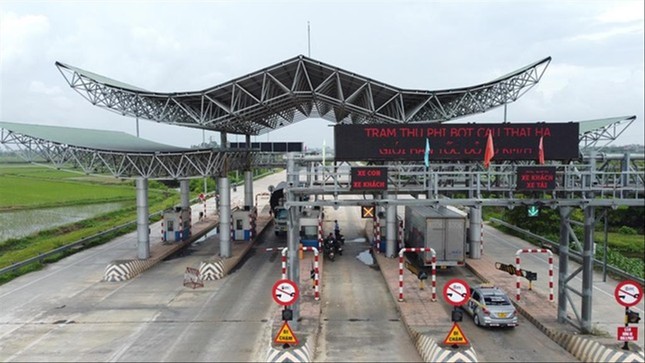Dividing into 3 “diseased” groups
According to information from the Ministry of Transport, the current difficulties and obstacles mainly focus on projects implemented before 2015. These are projects that have been completed and put into operation but have not collected tolls, or cannot collect tolls due to opposition from the locals or projects that have collected tolls but actual revenue is less than 30% of the financial plan in the contract…

Financial plan failure, BOT Thai Ha Investors want to return the project.
In addition, some BOT projects face difficulties in mobilizing credit capital (such as the BOT Construction Project of Hai Phong Coastal Road); difficulties in arranging state capital participation, land clearance work, high interest rates and large fluctuations in borrowing capital; the rate of state budget capital participation is difficult to attract investors; there is no specific guidance for PPP projects being implemented that must be suspended to switch to investment with state budget funds…
To solve long-standing difficulties, the Ministry of Transport proposes the Government to propose solutions to remove obstacles for 8 BOT projects in 3 groups. Accordingly, the first group is to amend the contract, supplement the budget to support 2 projects with decreased revenue that cannot be recovered with a total capital requirement of VND 1,557 billion.
“Using the budget to buy back BOT projects will create a bad precedent for investors to carry out ineffective projects, shifting responsibilities to the State. The Government needs to carefully consider this proposal, even if necessary, it needs to accept the pain once. In case the buyback decision is implemented, the Ministry of Transport needs to explain and ensure that the projects will be managed and operated effectively to avoid further losses in the future.”
Mr. Le Thanh Van – Standing Member of the Finance – Budget Committee of the National Assembly
Specifically, the Ministry of Transport proposes to supplement VND 522 billion for the BOT Construction Project of Viet Tri – Ba Vi bridge (Van Lang bridge). This project has a total investment amount that has been audited and settled at VND 1,088 billion. The expected payback period is about 22 years and the investor has agreed to reduce 50% of the profit on equity.
For the BOT Investment in the construction of Thai Ha Bridge crossing the Red River (connecting Thai Binh and Ha Nam provinces with Cau Gie – Ninh Binh expressway), the Ministry of Transport proposes to supplement VND 1,024 billion for support, expected payback time about 25 years.
The second group that the Ministry of Transport proposes is to adjust the state support mechanism. This solution applies to the BOT construction project of the road tunnel through Deo Ca. Accordingly, the Ministry of Transport proposes to allocate about VND 2,280 billion from toll revenue on the Ho Chi Minh road section from La Son to Tuy Loan to support the project. The expected payback period is about 28 years and 4 months. La Son – Tuy Loan expressway will study the toll collection plan for the state budget.
The third group consists of 5 projects: BOT Upgrading, renovating National Highway 91, Can Tho City (not collected at toll booth T2), BOT Construction Project of Thai Nguyen – Cho Moi road and upgrading, renovating National Highway 3 from Km75 – Km100 (not collected at toll booth 3 National Highway); BOT Upgrading, expanding Ho Chi Minh road from Km1738 + 148 – Km1763 + 610 (Dak Lak province), Construction Project of Binh Loi railway bridge and renovation of Saigon River channel; Project of the Western Ring Road of Thanh Hoa City from Km0 – Km6. With these projects, the Ministry of Transport proposes the Government to allocate more than VND 6,810 billion to terminate the contract before the deadline.
Ensuring no additional losses
Mr. Le Thanh Van – Standing Member of the Finance – Budget Committee of the National Assembly, believes that the budget should not be used to buy back BOT projects. According to Mr. Van, when the BOT project is losing money, the first thing to consider is the responsibility of individuals and collectives who have proposed, appraised and decided to implement the project. In addition, both the budget estimate for public investment and regular spending for serving socio-economic development do not have a budget estimate for buyback BOT projects.
“Using the budget to buy back BOT projects will create a bad precedent for investors to carry out ineffective projects, shifting responsibilities to the State,” said Van, adding that the Government needs to carefully consider this proposal, even if necessary, it needs to accept the “pain once”. In case the buyback decision is implemented, the Ministry of Transport needs to explain and ensure that the projects will be managed and operated effectively to avoid further losses in the future.
According to Mr. Nguyen Huu Duc, a transportation expert, when a BOT project fails, the solution often given is that the project’s participants including the State, investors, and banks must share risks. However, banks do not sign contracts with the State but stand behind the investor, so only the State and the investor remain to implement the project.












